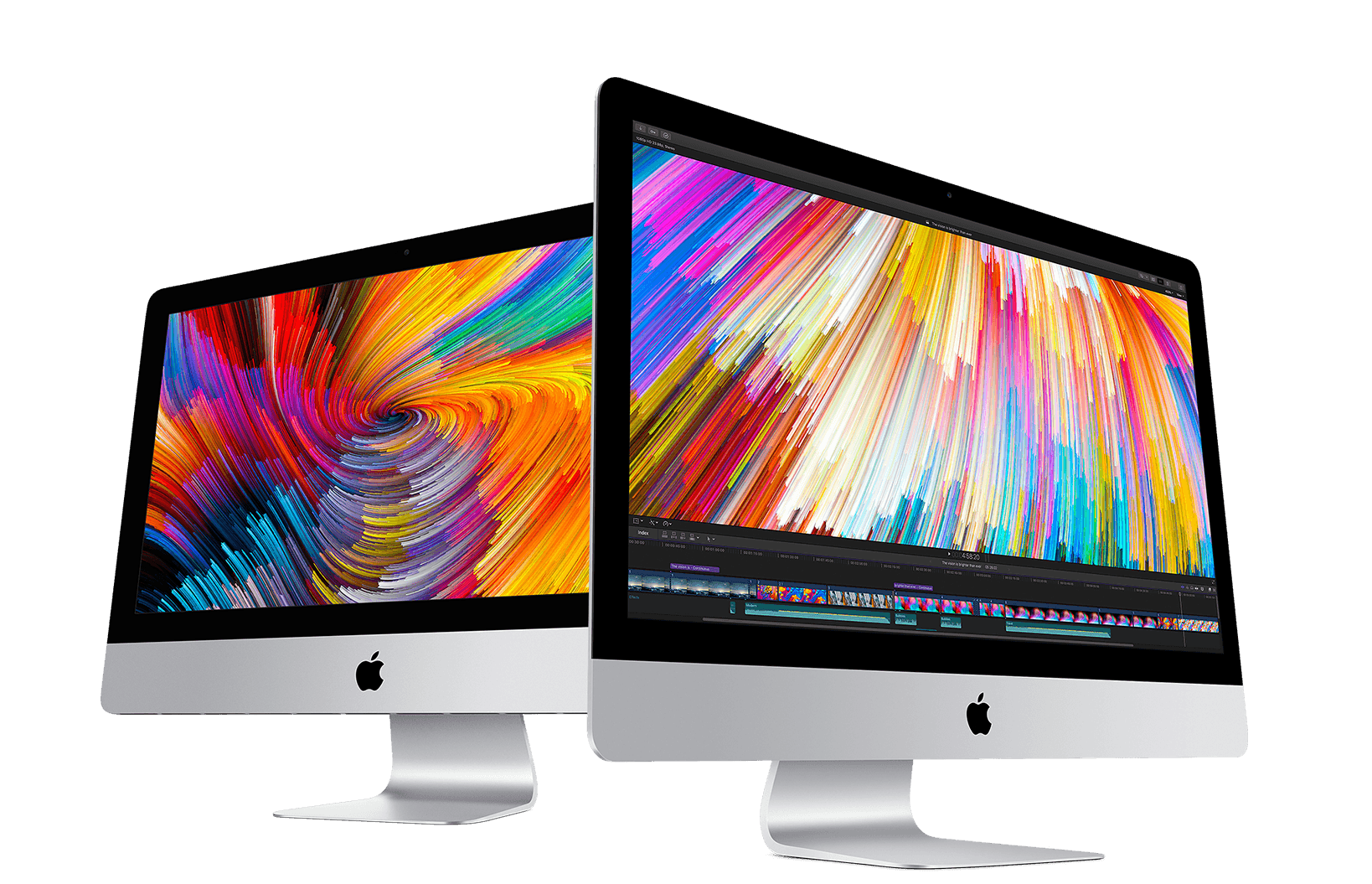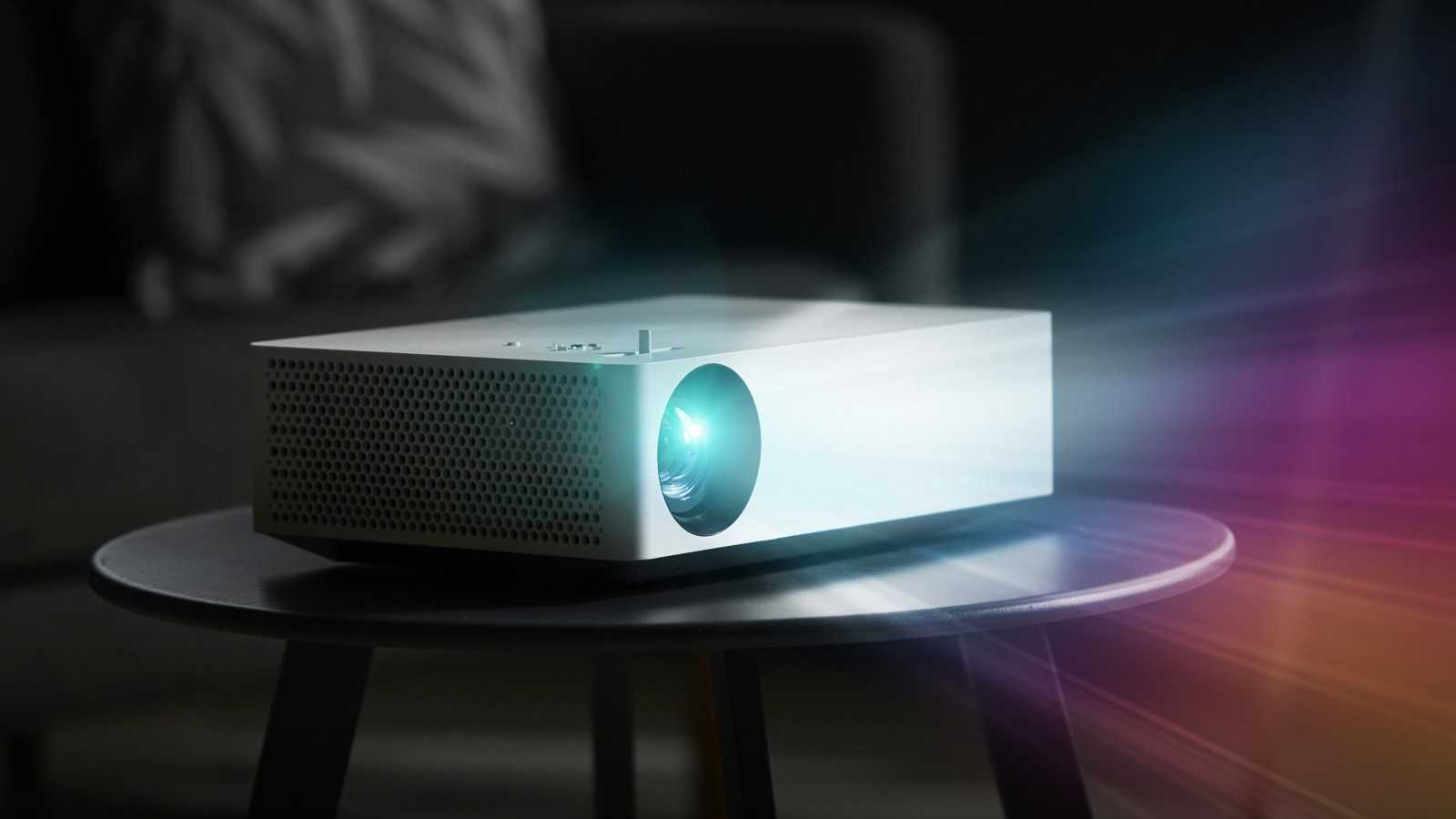ViewSonic Pro9000 Performance
With both Prometheus and our tried and tested Harry Potter and The Deathly Hallows Pt II on Blu-ray, the ViewSonic Pro9000 proves a very interesting watch. Not an entirely satisfactory one, it must be said, but certainly interesting.
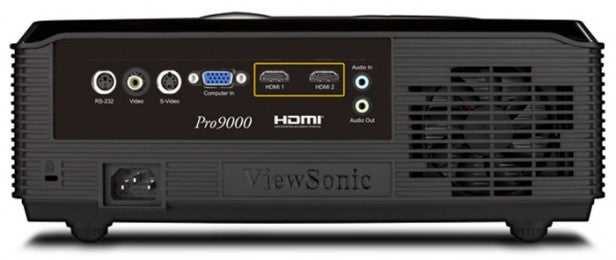
The first thing that struck us was just how diverse a range of base colour temperatures the ViewSonic Pro9000 delivers via its Gamma settings. We found ourselves jumping between at least five of the seven provided modes numerous times before eventually settling on number four. And even then we found ourselves tinkering at some length with the projector’s colour management features before we felt we’d nailed the best movie colour performance the projector can deliver.
What we’re getting at here is that the colour range possible from the laser technology really does seem extreme. This is in most ways good news, but it does also mean you have to put in more effort with the ViewSonic Pro9000 than you do with many rival projectors to get colours looking their best.
Once you’ve got over this setup hurdle, though, you grow to greatly appreciate the ViewSonic Pro9000’s colour efforts. It really does deliver not just a range but also a subtlety of tone that’s not hitherto been seen on such an affordable single-chip DLP projector.
This is especially apparent while studying skin tones. Both Prometheus and Harry Potter present real challenges for any video display in this respect, but the ViewSonic Pro9000 reproduces not only the diversity of flesh tones but also every little subtlety within each different facial close-up with impressive colour accuracy.
Another example of the ViewSonic Pro9000’s colour performance in action is the scene where Harry, Hermione and Ron change clothes on a moor after jumping off a dragon (as you do). The projector produces a more tonally rich representation of the grassland backdrop than any affordable projector we’ve seen before.
The ViewSonic Pro9000 also impresses with its motion reproduction. Both camera pans and motion within a frame are handled with aplomb, looking free of judder, blur and the sort of fizzing artefacts you commonly get with normal single-chip/colour wheel DLP projectors. Excellent.
ViewSonic Pro9000 Picture Quality
Also very good is the ViewSonic Pro9000’s handling of detail. HD pictures look extremely sharp and polished, yet crucially this sharpness doesn’t look forced or over-cooked. Furthermore, as usual with DLP technology there’s no sense of the grid-like structure of pixels that you can sometimes see with rival-tech projectors.
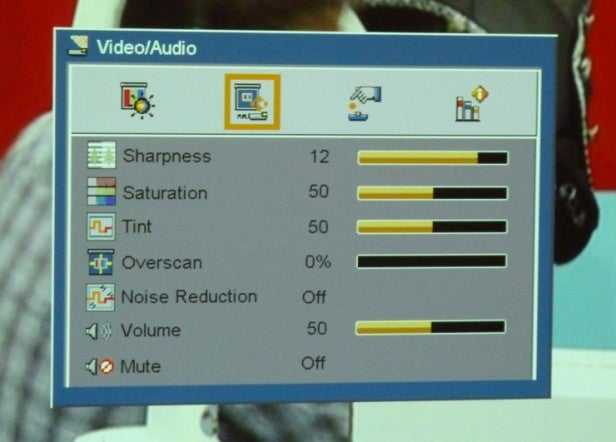
It’s also a great relief to be able to watch a single-chip DLP projection image that, true to ViewSonic’s promise, isn’t troubled at all by the rainbow effect that’s so commonly an irritant with normal UHP lamp/colour wheel models.
In many ways, then, it really isn’t a stretch to describe the ViewSonic Pro9000’s pictures as genuinely filmic, at least at times. However, aside from the aforementioned difficulties in settling on the best colour settings, there are a few other significant flaws to report.
The most disappointing of these concerns the ViewSonic Pro9000’s black level response. Both the films we used predominantly for our tests feature lots of very dark content, and the laser tech struggled to handle this convincingly, despite the 100,000:1 contrast claims and despite the fact that pictures aren’t as bright as we’d hoped they might be from the 1,600 ANSI Lumens brightness claim.
There’s that all-too familiar grey (or bluish or greenish, depending on your gamma choice) wash over parts of the picture that should be black. This leaves dark scenes looking rather flat, low on shadow detail, and just not totally convincing. Especially as the inability to render a true-looking black also damages the projector’s colour capabilities when showing dark shades.
Another problem that’s also at its most noticeable during dark scenes is a sort of greenish speckling noise. This is readily visible over dark and mid tones if you get quite close to your screen, but it’s also visible in a more ‘general’ way as a vague fizzing effect from normal viewing distances.
Our final complaint about the ViewSonic Pro9000 picture quality is that occasionally the very lightest parts of pictures can look ‘flared out’. In other words, a loss of subtle shading in these light areas can leave them looking like empty white holes ripped from the picture.
Основные характеристики Мультимедийные проекторы Pro9000
| Основное | |
|---|---|
| Класс устройства | портативный |
| Тип устройства | DLP |
| Рекомендуемая область применения | для домашнего кинотеатра |
| Реальное разрешение | 1920×1080 |
| Широкоформатный | Есть |
| Проекция | |
| Частота строчной развертки | 15-100 кГц |
| Частота кадровой развертки | 50-85 Гц |
| Дополнительно | |
| Уровень шума | 28 дБ |
| Комплектация | Инструкция по эксплуатации, Кабель питания, Пульт ДУ |
| Количество встроенных грмкоговорителей | 1 |
| Мощность каждого громкоговорителя | 2 Вт |
| Цвет | черный |
| Габариты | |
| Размеры (ШxВxГ) | 321 x 248 x 111 |
| Вес | 4,26 кг |
| Лампа | |
| Тип лампы | LED |
| Срок службы лампы | 20000 часов |
| Количество ламп | 1 |
| Изображение | |
| Контрастность | 100000:1 |
| Световой поток | 1600 люмен |
| Поддерживаемые системы вещания | PAL,SECAM,NTSC |
| Поддерживаемые форматы входного сигнала | 480i,480p,575i,575p,576p,720p,1080i |
| Интерфейсы | |
| Входы | VGA, Video, S-video, аудио Mini Jack, HDMI / DVI-D |
| Порты | RS-232 |
| Выходы | аудио Mini Jack |
ViewSonic Pro9000 Setup
Setting up the ViewSonic Pro9000 is a rather disappointing experience. For starters, there’s no vertical image shifting. While we can tolerate this – just – on sub-£1000 projectors such as the BenQ W1060, not being able to optically move pictures up and down is a real blow on a £1,600 model. After all, it means that the vast majority of people will have to resort to using keystone correction to get the edges of their pictures straight – and as we’ve pointed out many times before, whenever you use keystone correction you’re essentially distorting the image from its original pixel-mapped state.
We were also saddened to find only a 1.2x optical zoom, making the ViewSonic Pro9000 relatively hard to position correctly in your projection room.
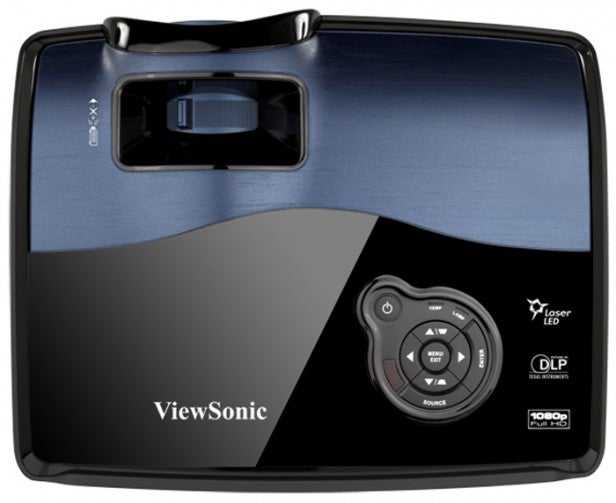
The ViewSonic Pro9000’s remote control is nothing to write home about either. It’s backlit, thankfully, but its layout is cluttered and its finish cheap and plasticky.
Viewsonic Pro9000 Specs
The advantages of using a laser to illuminate the pictures of the £1,600 ViewSonic Pro9000 rather than a traditional lamp are five-fold, so far as we can tell. From a picture quality point of view, probably the chief advantage is that there’s no need to use a colour wheel – a fact which should result in the end of single-chip DLP’s rainbow noise and motion fizzing problems.
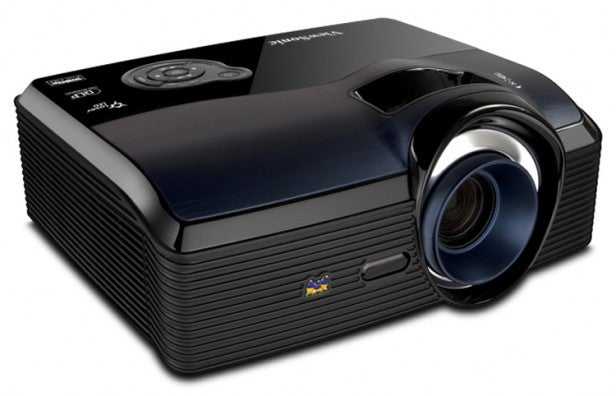
Also, ViewSonic maintains that laser hybrid LED projectors deliver a 50 per cent wider colour gamut than standard UHP lamp projectors, and benefit contrast too, with the ViewSonic Pro9000 claiming an eye-catchingly high 100,000:1 contrast ratio.
On top of this there are the practical benefits of laser lighting. For instance, ViewSonic claims a 20,000-hour lifetime for its solid-state lasers – between five and 10 times as long as you’ll get from a typical projection lamp. With replacement lamps for normal projectors costing £150 and beyond, the ViewSonic Pro9000 could thus present heavy users with a considerable long-term saving – a fact which makes the £1,600 price look a little more potentially reasonable than it was already for a projector using ground-breaking tech.
ViewSonic also contends that the Pro9000 doesn’t need to use fans to keep the lighting system cool. You can thus unplug the projector as soon as you’ve switched it off rather than having to wait for the lamp to cool down. Plus, of course, no fans means no fan noise. Or it would do if the ViewSonic Pro9000 sadly didn’t require a (thankfully not too noisy) fan to prevent other parts of the projector’s innards from overheating.
At this point we should quickly explain how laser LED technology – used in conjunction with a DLP optical system – actually works. It essentially employs a combination of blue and red LEDs, blue lasers and green phosphors, with the blue laser passing through a clear segment to excite green phosphors on the other side. The primary light colours are then consolidated, before being reflected from a typical DLP’s digital mirror device (DMD) into the lens.
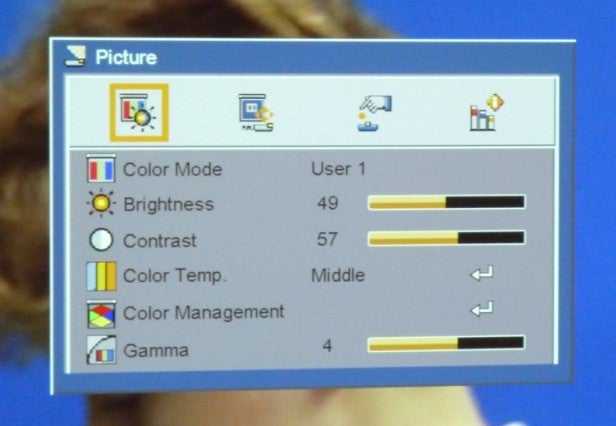
If you’re wondering why this approach can deliver an enhanced colour gamut, the main reason is the way it allows for an enriched delivery of the green primary colour. Green is responsible for around 60 per cent of colour composition, yet conventional lamp technologies struggle to recreate this green dominance effectively, leading to pictures that can look either too red/warm or too blue/cool. Especially at the relatively cheap end of the projection market.
ViewSonic Pro9000 Connectivity
On the upside, the ViewSonic Pro9000 connectivity options are decent, with highlights of two v1.3 HDMIs, a D-Sub PC port, and a component video input. The onscreen menus are reasonably appealing too, albeit perhaps a touch smaller than they could be.
Features within these menus are passably plentiful, including the facilities to adjust the red, green and blue gain of the colour temperature; the hue, saturation and gain balance of each of the six main colour elements; and the projector’s fundamental gamma settings.
The ViewSonic Pro9000’s design is best described as… unusual. Its grilled sides and reasonably compact size could belong to any number of other projectors, but its disproportionately large lens and cowling certainly makes it stand out from the crowd, as does the unusual 50-50 split of glossy and ‘brushed’ finish on the projector’s top edge. The slight blue tinge to the brushed section isn’t something you see every day, either.
Overall the ViewSonic Pro9000 design is a bit too busy for our tastes, but you probably won’t be looking at it much anyway once you’ve dimmed the lights and settled down to watch a film. Which is exactly what we’re about to do…
Viewsonic Pro9000 Projector Overview
❮
❯
A few months ago, one of our other reviewers (Mike) looked at a «business version» of thePro9000 projector. That model, the Pro8300, looks the same, but performs very differently. Thiss Pro9000 is geared for better contrast and blacks, as one would expect from a home theater projector, while the business version has far lower contrast (and blacks) but also more lumens. The real difference is the LED/Laser light source of this Pro 9000, compared to the conventional lamp in the Pro8300.
Essentially, our job here is not just to see how well the Pro9000 projector performs compared to the competition. We also want to help you determine value: How the light sources advantages — long life, very slow loss of brightness and very slow to have color shifts — trade off with the primary disadvantage: The higher cost due to the light source.
By our reckoning, this Viewsonic projector will be a much better value for those planning on keeping it years — say 4-5 years or longer, than the hobbyist type who replaces a projector every year or two, or maybe three.
If you own this projector long term, you will get your value out of the light source, and likely save money overall. You’ll be saving big on electricity too.
Rated 20,000 hours it should last as long as 5 to 10 conventional lamps depending on the projector you are comparing it to. Note that the Pro8300 mentioned above is rated 2500 hours on its lamp, when running at full power.
Let’s not worry about those issues of price vs. life, for now, and instead concentrate on the features that this Viewsonic Pro9000 projector offers.
The Pro9000 is (lightsource notwithstanding) a fairly typical single chip DLP projector that one would find in the $1500 up to perhaps $2500 dollar range in terms of overall features. As with many single chip DLP’s for a great many years, the Viewsonic Pro9000 has a basic 1.2:1 zoom lens. Most folks buying this projector will either ceiling mount, others will place on a table top. As is typical of lower cost DLP projectors, this Viewsonic projector lacks lens shift.
Unlike a great many new home theater projectors, the Viewsonic Pro9000 is 2D only. While a fair number of projector buyers are really into 3D (myself included), a lot of folks say they can take it or leave it, or aren’t in any hurry. That decision is yours. If nothing else, that simplifies some of your decisions. If you really want 3D, you will be looking elsewhere.
You’ll find that the brightness of this Viewsonic projector is about what we’ve called average for dedicated home theater projectors over the years. That’s about 500 lumens calibrated, and about 1000 lumens in a «brightest» mode that has been tweaked a bit to provide better color, as long as there is no dramatic drop in brightness, by doing those adjustments. Note that, as most new home projectors sport 3D, those newer ones tend to be brighter than average, with a number of them outputting close to, or even more than 2000 lumens in their adjusted «brightest» modes. Those guys are equally suitable for more «living room» or «family room» type environments where lighting control isn’t as good.
In a dark room a a proper screen the Viewsonic Pro9000, should have no problem filling 110″ diagonal screens, or perhaps a little larger.
The Pro9000 has a dynamic iris for improved contrast and black level performance.
CFI — Creative Frame Interpolation — smooth motion — is found on most over $2000 projectors, but few under $2000 projectors. You won’t find it on this Viewsonic, which isn’t surprising. I suspect that if Viewsonic built a version of the Pro9000, but using a conventional lamp, it would sell for about $1000 less, money you would recoup over the life of the projector. Personally if I’m working with a projector that has CFI, I primarily use it for sports, never for movies (except to confirm that I don’t want it on). I’ve never conisdered CFI to be a particularly key feature to have, more of a «nice touch» that has some trade-offs.
Lot’s to cover.
Характеристики
Разрешение 1,920×1,080, 1600 люмен ANSI, 133x321x260 мм, 4,3 кг
Проекторы для домашних кинотеатров обычно бывают двух видов — DLP и LCD. Новинка от Viewsonic — ни то, ни другое — в Pro9000 используется гибридная светодиодная система, которая устраняет необходимость в традиционной лампе, что делает его идеальным компактным проектором для небольшой гостиной или домашнего кинотеатра.
Хотя он по-прежнему использует чип DLP для получения изображений, они окрашены и проецируются с использованием комбинации лазеров и красного, синего и зеленого светодиодов. Это означает, что проектору не требуется цветовой круг, основная причина эффектов радуги в моделях DLP начального и среднего уровня. Это, безусловно, произвело впечатление в нашем тестировании, не показывая никаких признаков цветовой полосы, которую мы обычно испытываем с DLP-проекторами.

Исключение лампы значительно уменьшает количество тепла, выделяемого проектором, делая его более удобным для сидения при просмотре фильма. Если вы не планируете устанавливать потолочное крепление, Pro9000 будет удобно сидеть на журнальном столике, не превращаясь в миниатюрный радиатор. Кроме того, он тише, потому что вентилятор не должен так агрессивно охлаждать устройство. Viewsonic утверждает, что она производит 28 дБ в обычном режиме и 22 в эко-режиме; оба значения значительно меньше, чем у традиционных DLP-проекторов. Мы, конечно, заметили разницу в повседневном использовании, даже когда сидели в нескольких футах от него. Наконец, он использует меньше энергии для создания изображения, и он должен длиться дольше. Он рассчитан на 20 000 часов использования, что составляет около трех часов в день на протяжении более 150 лет.
Мы беспокоились, что гибридная проекция повлияет на яркость, но ее 1600 люмен оказались более чем достаточными для нашей темной испытательной комнаты. Он также хорошо справлялся в ярко освещенной комнате на коротких расстояниях проезда, хотя более темные изображения были заметно менее четкими, а цвета были не такими яркими. Как и с большинством проекторов, вам действительно нужно выключить свет, чтобы получить лучшее от Pro9000.
Качество изображения было впечатляющим для проектора среднего диапазона. Светодиодная проекция создавала яркие цвета, которые действительно оживляли анимационные фильмы, такие как Ice Age 2. Более темные и мрачные фильмы, такие как Casino Royale, выигрывают от своей автоматической системы диафрагмы, которая динамически регулирует яркость для повышения уровня черного, но мы не думали, что она будет значительно лучше, чем любой другой DLP-проектор среднего диапазона. Тон кожи был в основном ровным, но точность цвета оставляла желать лучшего.
Мы заметили, что довольно много дрожания, и без параметров сглаживания изображения на проекторе вам нужно будет включить эту функцию на вашем Blu-ray плеере. Без этого движение было заметно резким, особенно во время боевых сцен. Если у вас нет проигрывателя Blu-ray, способного на это, это, безусловно, ограничит привлекательность Pro9000.


Несмотря на то, что он не имеет лучшего внешнего вида экранного интерфейса, Pro9000 по крайней мере функционален. Достаточно просто перемещаться между меню, изменять настройки изображения и звука с помощью пульта дистанционного управления (с подсветкой). Помимо небольшой коллекции предустановок изображения, есть два пользовательских режима, которые позволяют изменять яркость, контрастность, цветовой режим, гамму и насыщенность, а также возможность включить шумоподавление.
Обзор Мультимедийные проекторы Pro9000
Гибридная Laser LED технология
Технология, используемая в проекторе Pro9000, позволяет создает основные цвета RGB напрямую от без использования цветового круга. Это означает, что эффект радуги и иные «паразитные» искажения изображений существенно минимизированы, а точность цветопередачи заметно улучшена по сравнению с традиционными ламповыми проекторами.
Full HD 1080p
ViewSonic Pro9000 поддерживает разрешение full HD 1920×1080 (1080p), а используемая в нем технология DarkChip3 от Texas Instruments позволяет создавать более четкие, чистые изображения. Проектор идеален для просмотра любого HD контента (1080p/1080i/720p), будь то кинофильмы, видео, игры, спортивные трансляции.
Коэффициент контрастности 100,000:1
Pro9000 обеспечивает яркость 1,600 ANSI люмен с контрастностью 100,000:1 для более четкого, детализированного отображения всех полутонов серого, что является основой к четкости и детализации изображения в целом, особенно в темных сценах. Pro9000 — отличный выбор для домашнего кинотеатра или в качестве развлекательного центра.
ViewSonic Pro9000 Features
Moving away from the laser system in search of other key features, the ViewSonic Pro9000 is a full HD model that accompanies its 100,000:1 contrast ratio claim with a surprisingly high 1,600 Lumens of claimed peak brightness. This is exciting because the only other laser-based projector we’ve ever seen, the Microvision ShowWX ‘Pico’ model, was let down by a pretty fundamental lack of brightness. Hopefully the ViewSonic Pro9000 will also prove immune to the aggravating speckling problem exhibited by the Microvision effort.
Before we get too excited by the ViewSonic Pro9000’s apparent brightness, though, the spec sheet also only recommends a maximum image size of 150-inches diagonal, while truly bright projectors tend to work comfortably at 200-inches and beyond.
